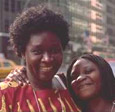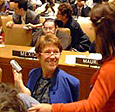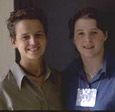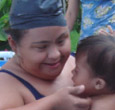WomenWatch: Feature on Women with Disabilities (original) (raw)
Sections:
- Convention on the rights of persons with disabilities
- Fact Sheet
- Citations
- UN enable
- Resources on other UN websites
- UN publications and documents
- Related UN events
- Webcast of the Convention
Page Content
Women with Disabilities
About 650 million people in the world—or 10 per cent of the world’s population— live with disabilities, and frequently encounter a myriad of physical and social obstacles. They often lack the opportunities of the mainstream population and are usually among the most marginalized in society. Women face barriers to full equality and advancement because of such factors as race, age, language, ethnicity, culture, religion or disability.1 Persistence of certain cultural, legal and institutional barriers makes women and girls with disabilities the victims of two-fold discrimination: as women and as persons with disabilities.2
 "Girls and women of all ages with any form of disability are among the more vulnerable and marginalized of society. There is therefore need to take into account and to address their concerns in all policy-making and programming. Special measures are needed at all levels to integrate them into the mainstream of development."3
"Girls and women of all ages with any form of disability are among the more vulnerable and marginalized of society. There is therefore need to take into account and to address their concerns in all policy-making and programming. Special measures are needed at all levels to integrate them into the mainstream of development."3
Often, women with disabilities are invisible both among those promoting the rights of persons with disabilities, and those promoting gender equality and the advancement of women. This page on Women with Disabilities aims to increase awareness about the rights and the situation of women with disabilities by serving as a portal to resources and the work of the United Nations in this area.
Convention on the rights of persons with disabilities
Background
 The rights of persons with disabilities are grounded in a broad human rights framework based on the United Nations Charter, the Universal Declaration of Human Rights, international covenants on human rights and other human rights instruments. On 13 December 2006, the General Assembly adopted the Convention on the Rights of Persons with Disabilities. The Convention on the Rights of Persons with Disabilities and the Optional Protocol to the Convention entered into force on 3 May 2008.
The rights of persons with disabilities are grounded in a broad human rights framework based on the United Nations Charter, the Universal Declaration of Human Rights, international covenants on human rights and other human rights instruments. On 13 December 2006, the General Assembly adopted the Convention on the Rights of Persons with Disabilities. The Convention on the Rights of Persons with Disabilities and the Optional Protocol to the Convention entered into force on 3 May 2008.
The text of the Convention contains an article on women with disabilities, as well as several references to girls, women, and gender issues. The section below links information related to the article on women with disabilities.
Women with disabilities in the text of the Convention
Excerpts from the Convention:
Preamble
(p) Concerned about the difficult conditions faced by persons with disabilities who are subject to multiple or aggravated forms of discrimination on the basis of race, colour, sex, language, religion, political or other opinion, national, ethnic, indigenous or social origin, property, birth, age or other status,
(q) Recognizing that women and girls with disabilities are often at greater risk, both within and outside the home of violence, injury or abuse, neglect or negligent treatment, maltreatment or exploitation,
(s) Emphasizing the need to incorporate a gender perspective in all efforts to promote the full enjoyment of human rights and fundamental freedoms by persons with disabilities,
Article 3 - General Principles
The principles of the present Convention shall be:
(g) Equality between men and women;
 Article 6 – Women with disabilities
Article 6 – Women with disabilities
1. States Parties recognize that women and girls with disabilities are subject to multiple discriminations, and in this regard shall take measures to ensure the full and equal enjoyment by them of all their human rights and fundamental freedoms.
2. States Parties shall take all appropriate measures to ensure the full development, advancement and empowerment of women, for the purpose of guaranteeing them the exercise and enjoyment of the human rights and fundamental freedoms set out in the present Convention.
Other references to women and gender issues are found in the following articles:
Article 8 – Awareness-raising (paragraph b)
Article 16 – Freedom from exploitation, violence and abuse (paragraphs 1,2,4,5)
Article 25 – Health (chapeau and paragraph a)
Article 28 - Adequate standard of living and social protection (paragraph 2b)
Article 34 – Committee on the Rights of Persons with Disabilities (paragraph 4)
Background information on the article on women with disabilities
Proposed revisions and amendments to the text of the Convention, Eighth session, 14 - 25 August 2006:
- Governments
- Non-Governmental Organizations
International Disability Caucus
IDC on Women and Gender Issues (MS Word)
Fact Sheet Treaty Body, 25 July (MS Word)
Background Documents: Third to Seventh Session
Background document: Towards a Gender Sensitive Disability Rights Convention. Side event to the Second session of the Ad Hoc Committee, 20 June 2003.
Related links
Handbook for Parliamentarians on the Convention
UN system vows to ensure rights of persons with disabilities
Landmark UN treaty on rights of persons with disabilities enters into force
International normative framework on women and girls with disabilities
Fact Sheet
About girls and women with disabilities
"Girls and women of all ages with any form of disability are generally among the more vulnerable and marginalized of society" ("Further actions and initiatives to implement the Beijing Declaration and Platform for Action", General Assembly Resolution S-23/3 of 10 June 2000, annex, paragraph 63).
Education
Employment and paid work
 "People with disabilities in general face difficulties in entering the open labour market, but, seen from a gender perspective, men with disabilities are almost twice as likely to have jobs than women with disabilities. When women with disabilities work, they often experience unequal hiring and promotion standards, unequal access to training and retraining, unequal access to credit and other productive resources, unequal pay for equal work and occupational segregation, and they rarely participate in economic decision-making" (Arthur O’Reilly. "Employment Barriers for Women with Disabilities" in "The Right to Decent Work of Persons with Disabilities" IFP/Skills Working Paper No. 14. International Labour Organization 2003).
"People with disabilities in general face difficulties in entering the open labour market, but, seen from a gender perspective, men with disabilities are almost twice as likely to have jobs than women with disabilities. When women with disabilities work, they often experience unequal hiring and promotion standards, unequal access to training and retraining, unequal access to credit and other productive resources, unequal pay for equal work and occupational segregation, and they rarely participate in economic decision-making" (Arthur O’Reilly. "Employment Barriers for Women with Disabilities" in "The Right to Decent Work of Persons with Disabilities" IFP/Skills Working Paper No. 14. International Labour Organization 2003).
Health
 "Every minute, more than 30 women are seriously injured or disabled during labor… However, those 15 – 50 million women generally go unnoticed"(World Bank, "Health, nutrition and population: Reproductive health and disability").
"Every minute, more than 30 women are seriously injured or disabled during labor… However, those 15 – 50 million women generally go unnoticed"(World Bank, "Health, nutrition and population: Reproductive health and disability").
"Women with disabilities, of all ages, often have difficulty with physical access to health services. Women with mental disabilities are particularly vulnerable, while there is limited understanding, in general, of the broad range of risks to mental health to which women are disproportionately susceptible as a result of gender discrimination, violence, poverty, armed conflict, dislocation and other forms of social deprivation" (Committee on the Elimination of Discrimination against Women General Recommendation 24 Women and Health, in relation to the Convention on the Elimination of All Forms of Discrimination against Women (Article 12) (Twentieth session, 1999, paragraph 25).
"Depressive disorders account for close to 41.9 per cent of the disability from neuropsychiatric disorders among women compared to 29.3 per cent among men" (Women's mental health: The Facts, World Health Organization)
Housing
 Download the fact sheet in PDF Format (60 K). If you do not have Adobe PDF Reader installed, click here to download the free software.
Download the fact sheet in PDF Format (60 K). If you do not have Adobe PDF Reader installed, click here to download the free software.
Citations
The challenges: multiple discriminations and societal barriers
"… women face barriers to full equality and advancement because of such factor as their race, age, language, ethnicity, culture, religion or disability" (Beijing Platform for Action, Chapter IV, Strategic objectives and actions, paragraph 46).
"People with disabilities often encounter attitudinal and environmental barriers that prevent their full, equal and active participation in society. These barriers impinge particularly on the well-being of persons with intellectual, mental or multiple disabilities. They add to the disadvantage customarily experienced by disabled persons belonging to such populations or social groups as women, children, the elderly and refugees" (Secretary-General of the United Nations in his report on the Implementation of the World Programme of Action concerning Disabled, A/49/435, Annex, paragraph 4).
"The consequences of deficiencies and disablement are particularly serious for women. There are a great many countries where women are subjected to social, cultural and economic disadvantages which impede their access to, for example, health care, education, vocational training and employment. If, in addition, they are physically or mentally disabled, their chances of overcoming their disablement are diminished, which makes it all the more difficult for them to take part in community life" (World Programme of Action concerning Disabled Persons, paragraph 45, General Assembly resolution 37/52 of 3 December 1982).
 Women with disabilities may be particularly at risk due to stigmas associated with both disability and gender inequality
Women with disabilities may be particularly at risk due to stigmas associated with both disability and gender inequality
"Thus we would now like to focus our attention on the negative consequences for women of the persistence of certain cultural barriers that make them the victims of a two-fold discrimination: as women and as disabled persons. Much has been written on discrimination against women, but very little has so far been done to deal adequately with the problem of disabled women. The few attempts made have been based on a mistaken approach, since they treat the acute problem of disability as part of the general topic of discrimination against women. However, sex and disability are two separate factors which, when combined in the same person, usually reinforce each other and compound prejudices" (Leandro Despouy, Special Rapporteur of the Sub-Commission on Prevention of Discrimination and Protection of Minorities, 1988, "Human Rights and Disabled Persons", Human Rights Studies Series, Number 6. Centre for Human Rights: Geneva, United Nations publication, Sales No. E.92.XIV.4, paragraph 140).
A call for action at all levels to ensure non-discrimination, enjoyment of all human rights and fundamental freedoms and inclusion into the mainstream of development
"All the arguments adduced in favour of women's full participation in the various spheres of cultural, political, economic life, etc., are doubly applicable to disabled women, not only regarding equal rights, but also with respect to the negative consequences for society in general of neglecting any human resource, for the community's failure to use it turns it into a burden for that community" (Leandro Despouy, Special Rapporteur of the Sub-Commission on Prevention of Discrimination and Protection of Minorities, 1988, "Human Rights and Disabled Persons", Human Rights Studies Series, Number 6. Centre for Human Rights: Geneva, United Nations publication, Sales No. E.92.XIV.4, paragraph 140).
"Girls and women of all ages with any form of disability are among the more vulnerable and marginalized of society. There is therefore need to take into account and to address their concerns in all policy-making and programming. Special measures are needed at all levels to integrate them into the mainstream of development" ("Further actions and initiatives to implement the Beijing Declaration and Platform for Action", General Assembly Resolution S-23/3 of 10 June 2000, annex, paragraph 63).
UN publications and documents
 United Nations Educational, Scientific and Cultural Organization (UNESCO)
United Nations Educational, Scientific and Cultural Organization (UNESCO)
United Nations Regional Commission for Asia and the Pacific (ESCAP)
World Health Organization
• Michelle K. Gomel, Nations for mental health: a focus on women, 1997 (WHO/MSA/NAM/97.4)
Footnotes:
1 Beijing Platform for Action, Chapter IV, Strategic objectives and actions, paragraph 46 [back to text]
2 Leandro Despouy, Special Rapporteur of the Sub-Commission on Prevention of Discrimination and Protection of Minorities, 1988, "Human Rights and Disabled Persons", Human Rights Studies Series, Number 6. Centre for Human Rights: Geneva, United Nations publication, Sales No. E.92.XIV.4, paragraph 140. [back to text]
3 "Further actions and initiatives to implement the Beijing Declaration and Platform for Action", General Assembly Resolution S-23/3 of 10 June 2000, annex, paragraph 63. [back to text]
- - - - - -
Images by U.N. Photo, FAO, Bejing+5 participants / Jeremy Thornton


